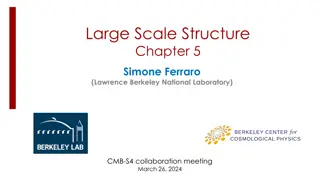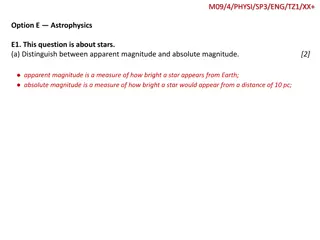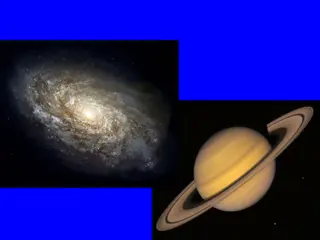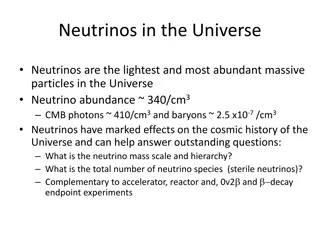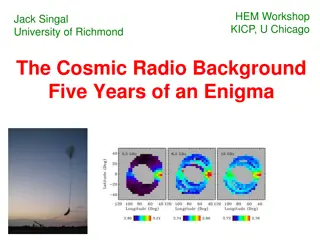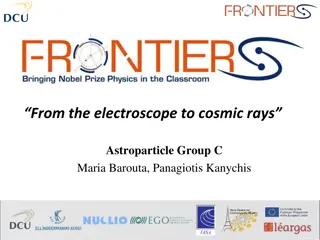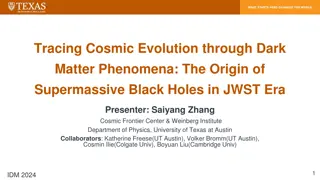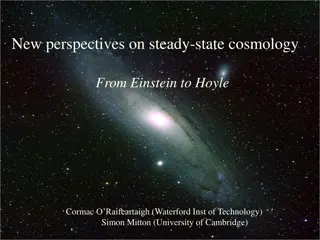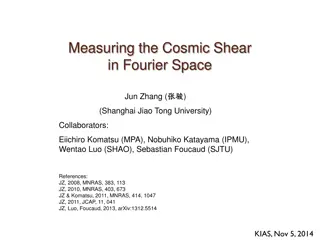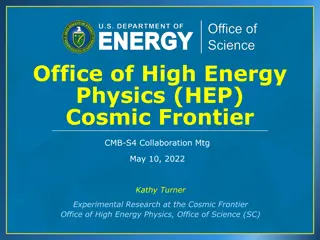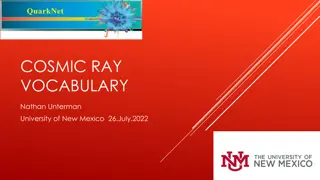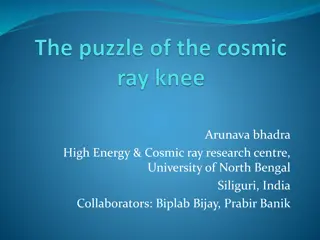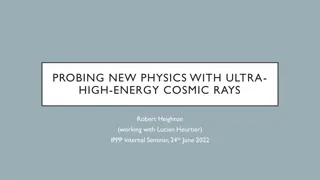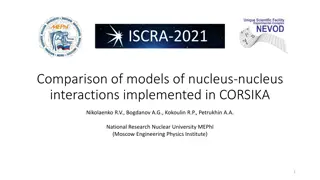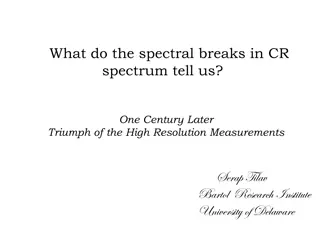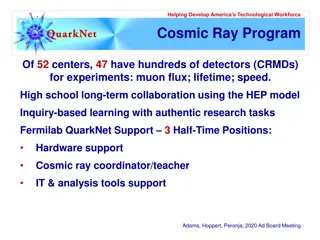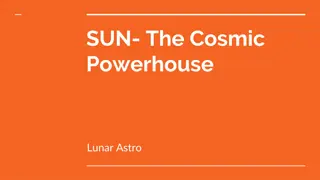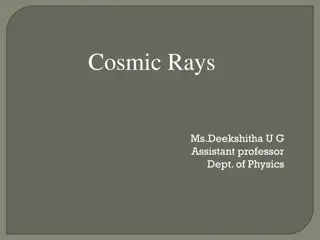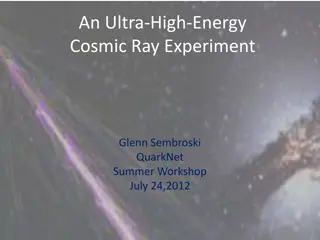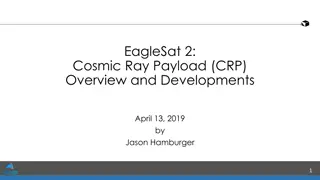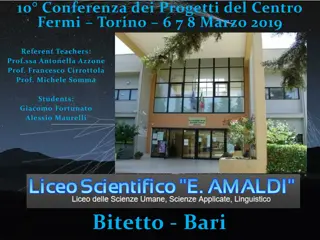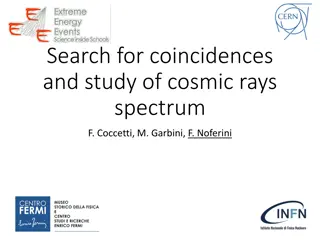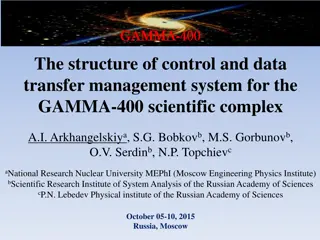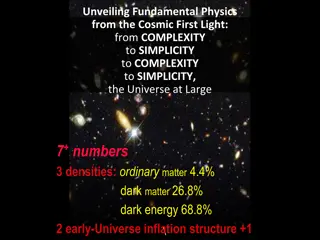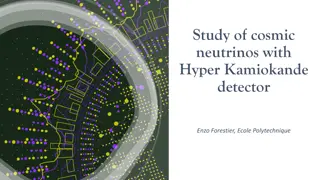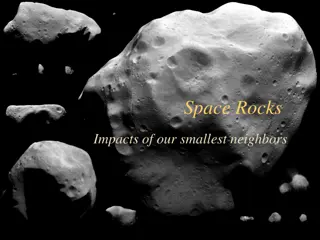❤[READ]❤ Cosmic Biology: How Life Could Evolve on Other Worlds (Springer Praxis
\"COPY LINK HERE ; https:\/\/getpdf.readbooks.link\/1441916466\n\nget [PDF] Download Cosmic Biology: How Life Could Evolve on Other Worlds (Springer Praxis Books) | Cosmic Biology: How Life Could Evolve on Other Worlds (Springer Praxis Books)\n\"\n
1 views • 6 slides
The Big Bang Theory and Evidence: A Brief Overview
The Big Bang theory proposes that the universe began with a violent expansion from a single point of pure energy around 13.787 billion years ago. Evidence such as red shift, the cosmic microwave background radiation, and the formation of fundamental particles supports this theory. The universe evolv
4 views • 18 slides
The Cosmic Conflict: Origins of Rebellion in Heaven
Immersed in a conflict of cosmic proportions, the story of rebellion in heaven unfolds through the fall of Lucifer, now Satan, who led a third of the angels in defiance against God. This eternal battle between good and evil continues to impact our choices and allegiances today, reminding us of the i
2 views • 11 slides
Large Scale Structure Chapter 5
Simone Ferraro from Lawrence Berkeley National Laboratory discusses the significance of Cosmic Microwave Background (CMB) experiments in probing the large-scale structure of the universe. Covering topics like the interaction of photons with matter, CMB lensing, and CMB lensing tomography, this prese
3 views • 21 slides
Exploring Stars, Cosmic Microwave Background Radiation, and Big Bang Evidence
Learn about stars, distinguish between apparent and absolute magnitude, compare luminosities and distances of different stars, analyze black body spectrum in cosmic microwave background radiation, understand evidence supporting the Big Bang model, and describe characteristics of red supergiant stars
0 views • 35 slides
Journey Through the Cosmos: From Einstein's Theories to the Big Bang
Explore the evolution of our understanding of the universe, from Einstein's initial beliefs in a static cosmos to the groundbreaking discoveries of an expanding universe and the Big Bang theory. Witness how observations of galaxies moving away in all directions and the cosmic microwave background ra
0 views • 13 slides
Insight into Neutrinos: Impacts on the Universe's Cosmic History
Neutrinos, the lightest and most abundant massive particles in the Universe, play significant roles in cosmic evolution. Their effects on large-scale structure, constraints on mass, and implications for fundamental questions provide valuable insights into the Universe's past and future research dire
0 views • 7 slides
The Cosmic Radio Background: Unraveling an Enigma
Delve into the mysteries of the cosmic radio background through discussions on isotropic radio skies, Galactic monopoles, extragalactic components, and limitations on magnetic fields. Explore the complexities of synchrotron emissions and their implications in understanding the universe.
3 views • 21 slides
Exploring Electroscope and Cosmic Rays in Science Education
This lesson pack delves into the construction and use of the electroscope, understanding static electricity, and detecting cosmic rays. Students engage in hands-on activities, explore the atom's structure, and learn about the interaction of particles with Earth's atmosphere. With a focus on inquiry-
0 views • 20 slides
Cosmic Bench Efficiency Characterisation Meeting Summary
The QA-QC meeting for Cosmic Bench on 11th January 2016 aimed to identify problems in the detection chain, including dead strips and inefficiencies. The setup involved reusing the M-Cube project's bench with modifications. The procedure included scanning a region, using modules equipped with DREAM e
0 views • 7 slides
Exploring Cosmic Ray Sources Using Gamma-Ray Emission Data
This study focuses on investigating ultrahigh energy cosmic ray (UHECR) sources by analyzing extragalactic diffuse gamma-ray emission data. Techniques such as examining UHECR mass composition and arrival directions, as well as studying interactions with cosmic microwave and extragalactic background
0 views • 16 slides
Exploring Cosmic Neutrinos: The GRANDProto300 Experiment in LengHu, China
Understanding the mysteries of ultra-high-energy cosmic rays and the connection to cosmic neutrinos is a pivotal quest in astrophysics. The GRANDProto300 experiment in LengHu, QingHai province, China, aims to detect cosmic neutrinos using the Giant Radio Array for Neutrino Detection. The experiment
0 views • 31 slides
Riccardo Giacconi: An Astounding Journey in Astrophysics
Riccardo Giacconi's remarkable journey in astrophysics from studying cosmic radiation in Milan to joining the American Science and Engineering company to pioneering cosmic X-ray astronomy. His pivotal role in setting up research groups, launching satellites, and significant observations in the field
0 views • 20 slides
Tracing Cosmic Evolution through Dark Matter Phenomena
Presenter Saiyang Zhang explores the origin of supermassive black holes in the JWST era, shedding light on SMBHs, their growth, Eddington limit, and implications for cosmology. The discussion delves into the role of dark matter, SMBH seeding, and the challenges posed to current cosmic structure theo
0 views • 23 slides
Revisiting Steady-State Cosmology: From Einstein to Hoyle
Explore the historical evolution of cosmological models from Einstein's steady-state theory to the Big Bang hypothesis, examining key figures, discoveries such as Hubble's law, and debates about the universe's expansion. The article delves into Einstein's contributions, the challenges of integrating
0 views • 18 slides
Topological Quintessence: Anomalous Cosmic Anisotropies and Dark Flow Directions
The consistency of Cold Dark Matter (CDM) with observational data has improved over the past decade, but tensions remain with various cosmic anomalies such as preferred anisotropy axes and dark flow directions. Topological Quintessence, a physical mechanism proposed by L. Perivolaropoulos and collab
0 views • 26 slides
Cosmic Shear Measurement in Fourier Space and Its Scientific Goals
Exploring the cosmic shear in Fourier space with a collaborative effort led by Jun Zhang from Shanghai Jiao Tong University sheds light on fundamental scientific questions related to dark energy, the geometry of the universe, General Relativity, cold dark matter, and cosmic structure density distrib
0 views • 48 slides
Understanding the Office of High Energy Physics (HEP) Cosmic Frontier
The Office of High Energy Physics (HEP) at the Department of Energy (DOE) plays a vital role in advancing our understanding of the universe at its most fundamental level. HEP's mission includes exploring the elementary constituents of matter and energy, investigating their interactions, and delving
0 views • 20 slides
Designing Veto Cosmic Ray Detector for JPET Using GEANT4 Simulations
Creating the Veto Cosmic Ray Detector for JPET involves designing the current version of Veto JPET, incorporating 42 scintillators, detecting 4 GeV cosmic muons, generating cosmic muon distribution, and simulating energy deposition inside the veto scintillators. The process includes particle generat
0 views • 26 slides
Searching for Dark Photon Dark Matter with Cosmic Ray Antideuterons
Exploring the use of cosmic ray antideuterons for dark matter detection is a promising avenue in astrophysics. Antideuteron searches offer a low-background environment, making them ideal for detecting certain types of dark matter particles. Unlike antiproton searches, which face significant backgrou
0 views • 30 slides
Exploring Cosmic Ray Vocabulary and Physics Concepts
Delve into the world of cosmic rays and physics terminology with definitions and explanations covering topics such as flux, relativity, half-life, trigger rates, and more. Discover the significance of muons, gates, stack arrays, and nanoseconds in the study of cosmic phenomena. Explore the tools and
0 views • 19 slides
Understanding Cosmic Ray Research: The Mysterious Knee in the Energy Spectrum
The energy spectrum of cosmic rays displays a unique power law behavior with distinct features such as the knee and the ankle. The knee, observed at around 3 PeV, marks a change in the spectral index. Various theories have been proposed to explain the origin of the knee, with suggestions ranging fro
0 views • 70 slides
Unraveling the Mysteries of Ultra-High-Energy Cosmic Rays and Neutrinos
Delve into the exploration of ultra-high-energy cosmic rays and cosmogenic neutrinos in the quest to uncover new physics phenomena. Examining the GZK limit, cosmic accelerators, detection methods, and the potential for detecting tau neutrinos in Earth, this seminar presents a comprehensive overview
0 views • 28 slides
Comparison of Models of Nucleus-Nucleus Interactions in CORSIKA
Introduction to the study on models of hadronic interactions at high energies implemented in CORSIKA, a simulation tool used to analyze cosmic ray interactions with Earth's atmosphere. The study compares four widely used models, detailing their features and variants in simulation parameters. Results
0 views • 10 slides
Understanding Background Tasks in .NET Core
Explore the world of background tasks in .NET Core with this informative slideshow by scottsauber. Learn about various types of background tasks, suitable problems, available options like IHostedService, BackgroundService, Worker Service, Hangfire, and more. Discover how to choose the right option f
0 views • 41 slides
Insights into Cosmic Ray Spectrum Breaks and Hardening after Centuries of High-Resolution Measurements
Spectral breaks in cosmic ray (CR) spectrum reveal rigidity-dependent behaviors, such as proton break at 240 GeV and remarkable hardening post-breaks. Various experiments like PAMELA, ATIC, CREAM II, and others showcase unique features and spectral indices, shedding light on CR composition and accel
0 views • 15 slides
Advancing America's Technological Workforce through Cosmic Ray Programs
Engage high school students in cutting-edge cosmic ray experiments, e-Lab analyses, and technology advancements to develop a skilled technological workforce. Foster collaborative learning, research tasks, and data-driven projects to enhance STEM education and prepare students for future innovation.
0 views • 8 slides
Unveiling the Cosmic Power of the Sun in Astrology
Discover the profound influence of the Sun as a cosmic powerhouse in astrology, shedding light on activation ages, case studies like Osho, and the significance of Sun dasa in shaping life events. Explore how Sun's positioning in the birth chart can impact one's willpower, intensity in life, and majo
0 views • 10 slides
Unveiling the Cosmic Evolution: A Journey Through Galaxies, Stars, and Empty Space
Delve into the intricate story of the universe's evolution from its hot dense origins to the vast cosmic web of stars and galaxies. Explore questions on stellar birth rates, interstellar medium influences, and the role of dark energy. Follow the journey of three students working on the Cosmic Evolut
0 views • 30 slides
Neutron Star Mergers and Ultra Heavy Element Cosmic Rays: Exploring Their Connection
Delve into the intriguing link between neutron star mergers and the synthesis of ultra heavy element cosmic rays. The rapid neutron capture process, known as r-process, plays a crucial role in creating elements heavier than iron through events like neutron star mergers and core-collapse supernovae.
0 views • 19 slides
Understanding Cosmic Rays: Types, Effects, and Theories
Cosmic rays are high-energy radiation particles originating from outer space, bombarding Earth's atmosphere. They can be classified based on penetration power and experimental observations. The intensity of cosmic rays varies with latitude, altitude, and direction. The Van Allen radiation belts surr
0 views • 9 slides
Exploring the Mysteries of Ultra-High-Energy Cosmic Rays
Delve into the enigmatic world of ultra-high-energy cosmic rays, pondering questions about their origins, energy spectra, measurement techniques, and the intriguing Greisen-Zatsepin-Kuzmin cutoff mystery. Uncover the complexities of cosmic rays through a captivating journey of cosmic exploration.
0 views • 21 slides
EagleSat.2 Cosmic Ray Payload (CRP) Overview
EagleSat.2 is a space mission designed to detect incoming cosmic ray particles and determine their direction and magnitude. The mission utilizes CMOS sensors and tungsten layers to capture data and estimate energy loss. Operational logistics include cycling sensors per orbit to manage power and data
0 views • 31 slides
Investigating Cosmic Rays with Student Researchers at Liceo Amaldi
A group of 40 students from Liceo Amaldi have been actively involved in the Extreme Energy Events project, studying cosmic rays and telescopic data. Utilizing software like Lazarus, Excel, and Root, they have analyzed the speed and angular distribution of cosmic ray muons. The students also went to
0 views • 19 slides
Insights into Cosmic Ray Spectrum and Coincidences Study
In-depth exploration of cosmic ray spectrum and coincidences study conducted by F. Coccetti, M. Garbini, F. Noferini, focusing on energy spectrum analysis of primary cosmic rays. The study involves simulations using Corsika, new tools like Coincidences DQM, and adjustments in parameter configuration
0 views • 9 slides
Solving Cosmic Gamma Background Anomaly: Ekaterina Shlepkina's Research Insights
Explore the quest to find a solution for the cosmic gamma background anomaly in cosmic rays through Ekaterina Shlepkina's research presented at the XXII International Workshop. Learn about the investigations into cosmic rays fluxes, antiparticle studies, and possible interaction types of Dark Matter
1 views • 19 slides
Overview of GAMMA-400 Scientific Complex
The GAMMA-400 Scientific Complex, designed by experts from National Research Nuclear University MEPhI and other institutions, consists of a gamma-ray telescope, space observatory, and various detectors for studying cosmic gamma emission, electron/positron fluxes, and cosmic-ray nuclei fluxes. The co
0 views • 16 slides
Unveiling Fundamental Physics from Cosmic First Light
Exploring the complexities and simplicities of the universe through cosmic observations, from the densities of ordinary matter to dark matter and dark energy. Images reveal the Milky Way in infra-red, the cosmic web of nearby galaxies, and the primordial light released billions of years ago. Planck'
0 views • 14 slides
Exploration of Cosmic Neutrinos with Hyper-Kamiokande and Graph Analysis
Delve into the study of cosmic neutrinos with the Hyper-Kamiokande detector at Ecole Polytechnique. Enzo Forestier, a motivated student, combines his passion for physics, space science, and meteorology with Japanese language skills. Through research projects ranging from rocket engines to satellite
0 views • 14 slides
Impacts from Space: A Journey Through Celestial Collisions
Explore the fascinating world of space rocks and their impacts on our solar system. From the asteroid belt to Jupiter's recent collisions, witness the remnants of cosmic encounters on moons, planets, and even Earth itself. Discover the history of impacts, including the catastrophic event that led to
0 views • 19 slides
![❤[READ]❤ Cosmic Biology: How Life Could Evolve on Other Worlds (Springer Praxis](/thumb/21556/read-cosmic-biology-how-life-could-evolve-on-other-worlds-springer-praxis.jpg)


